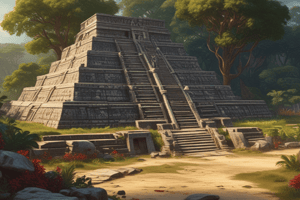Podcast
Questions and Answers
Which of these is a major urban site in the Valley of Mexico?
Which of these is a major urban site in the Valley of Mexico?
- Teotihuacan (correct)
- Cerro de las Mesas
- Cholula
- Monte Alban
What are the key issues defining the classic period?
What are the key issues defining the classic period?
Timing and characteristics, characteristics of Mesoamerican deities, planning at Teotihuacan, key artifacts, Teotihuacan contact with the Maya, decline of Teotihuacan.
The classic period was thought of as a golden age.
The classic period was thought of as a golden age.
True (A)
What was Teotihuacan known for in terms of governance?
What was Teotihuacan known for in terms of governance?
What unique urban feature did Teotihuacan have compared to other Mesoamerican cities?
What unique urban feature did Teotihuacan have compared to other Mesoamerican cities?
What notable characteristics define the Pyramid of the Sun?
What notable characteristics define the Pyramid of the Sun?
What might the Pyramid of the Moon have been modeled after?
What might the Pyramid of the Moon have been modeled after?
What does the Temple of Quetzalcoatl depict on its walls?
What does the Temple of Quetzalcoatl depict on its walls?
How was social stratification visible in the residential areas of Teotihuacan?
How was social stratification visible in the residential areas of Teotihuacan?
What describes cosmopolitan Teotihuacan?
What describes cosmopolitan Teotihuacan?
What was a distinctive feature of the compound layout in Tetitla?
What was a distinctive feature of the compound layout in Tetitla?
Flashcards are hidden until you start studying
Study Notes
Classic Period Key Sites
- Teotihuacan, located in the Valley of Mexico, features the Pyramid of the Sun, Pyramid of the Moon, Temple of Quetzalcoatl, and various palaces and apartment compounds.
- Cholula, in the Valley of Puebla, is known for its massive pyramid and as a center of Mixteca-Puebla art.
- Cerro de las Mesas in Veracruz was a central site of the Veracruz civilization, historically connected to the Olmec.
- Monte Alban in Oaxaca is a significant hilltop site, featuring elaborate tombs and incense burners, established during the Preclassic era.
Classic Period Key Issues
- The classic period spans from 150 AD to 900 AD and is characterized by defining elements such as timing and cultural features.
- Mesoamerican deities exhibit unique characteristics with rich mythologies.
- Teotihuacan’s city planning indicates advanced organization, with key artifacts like slab-foot cylinder vases and masks.
- Notable contact and influence between Teotihuacan and the Maya, including factors leading to the decline of Teotihuacan.
Rise of Great Civilizations
- The classic period is regarded as a golden age that saw widespread literacy through Mayan and Zapotec hieroglyphics.
- A significant population increase occurred during this time, with many ruins dating back to the classic period.
- Introduction of pottery molds possibly derived from South America.
Teotihuacan
- Teotihuacan featured a complex bureaucracy with evident military governance and warrior cults.
- Trade routes and contacts facilitated the exchange of art styles across Mesoamerica, suggesting both cultural spread and conquest.
- At its peak, Teotihuacan's influence was unmatched in the region.
Urbanism in Teotihuacan
- Teotihuacan was renowned for its planned urban layout, with good agricultural land and water sources.
- Legends describe it as a gathering place for gods to choose a sun god.
- City design features an intersecting avenue system dividing the city into quarters, anchored by three primary pyramids.
Pyramid of the Sun
- Positioned east of the Avenue of the Dead, constructed in stages during the late Preclassic.
- Each side measures 700 feet and rises to 200 feet, with remnants of an older pyramid inside.
- Associated with the storm god Tlaloc, featuring offerings of figurines and children, and a moat on three sides.
Pyramid of the Moon
- Contains six earlier pyramid structures, reflects the sacred Cerro Gordo mountain model.
- The first offering included various significant items, including eagles and human sacrifice.
- Burial of three elite Maya individuals on its summit around 350 AD highlights its cosmopolitan nature.
Temple of Quetzalcoatl
- Smaller than the main pyramids, it features a unique talud-tablero architectural style.
- Decorated with feathered serpent sculptures; its walls depict creation myths and contrasting themes of fire, water, and fertility.
- Sacrifices included 200 individuals, with notable looting and remains suggesting cultural significance and controversy.
Palaces and Apartment Complexes
- The city comprised walled residential areas divided into apartments, emphasizing social stratification.
- Differences in room sizes, artwork, and construction quality reflect varying social statuses among inhabitants.
- The compound layout may denote extended families living closely together.
Cosmopolitan Teotihuacan
- A melting pot of diverse cultures including Maya and Zapotec, with distinct neighborhoods reflecting different customs and gods.
- The western sector was predominantly Zapotec, while the eastern sector maintained strong connections with Veracruz and Maya civilizations.
Compound Layout (Tetitla)
- Residential compounds were one-story, square formations with temple structures arranged around central courtyards.
- Often featured small altars and possibly sunken basins for ritual purposes.
Studying That Suits You
Use AI to generate personalized quizzes and flashcards to suit your learning preferences.




